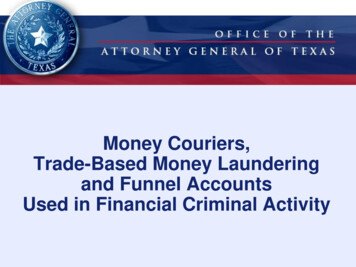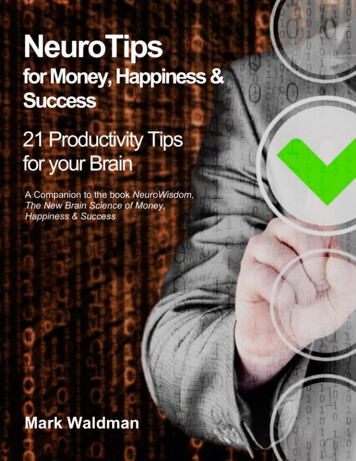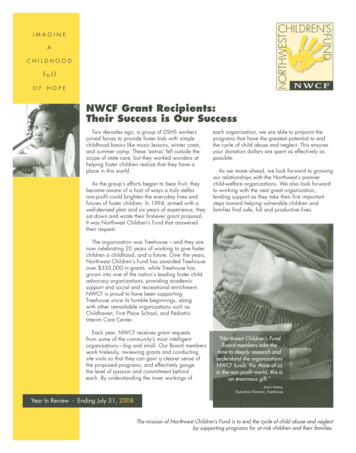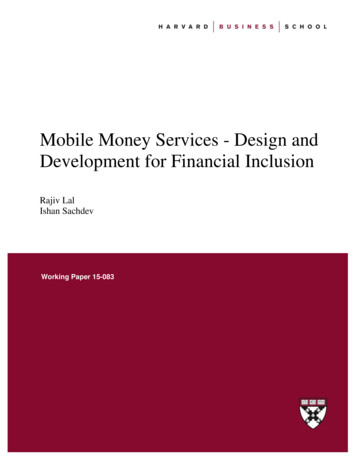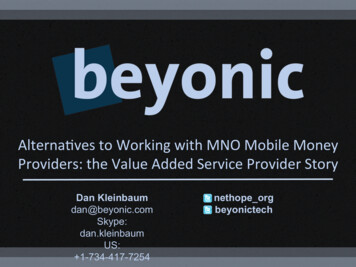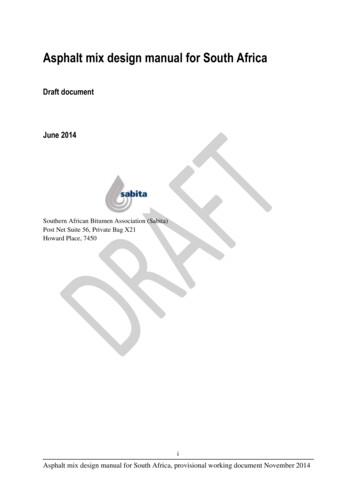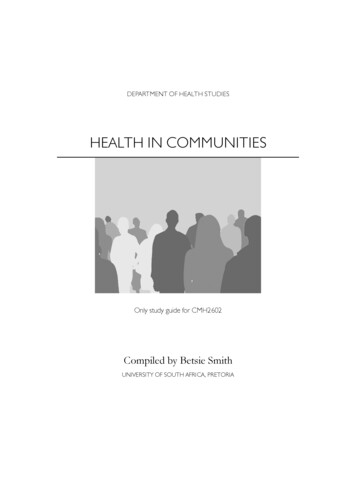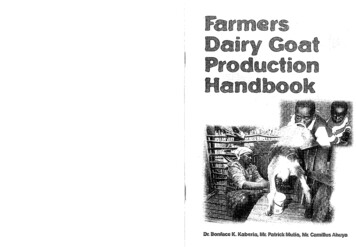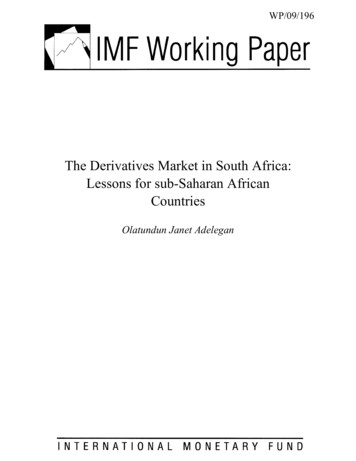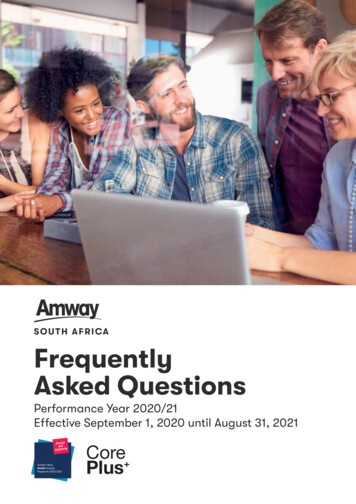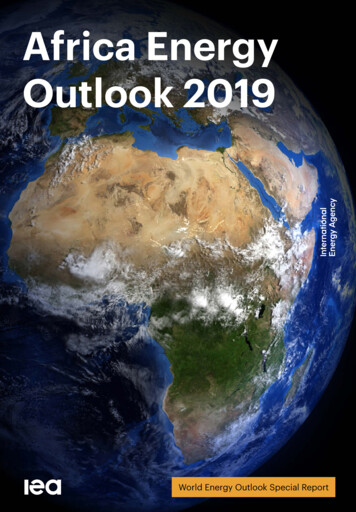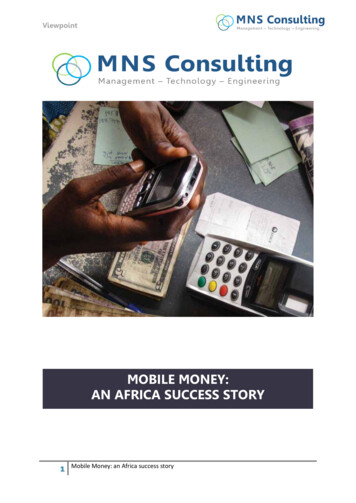
Transcription
ViewpointMOBILE MONEY:AN AFRICA SUCCESS STORY1Mobile Money: an Africa success story
Viewpoint1. It’s started as a frugal innovationAfrican mobile money story is known to have started in Kenya in 2007 when Safaricom launched itsM-PESA solution for peer to peer money transfer. Before that, due to a low rate of banking, sendingmoney to a relative could be a big issue. As counted by Nyagaka Anyona Ouko who claims to be theinnovator of this solution, the idea came as a “Eureka” moment. Knowing that most people have amobile and one can buy airtime to another, Ouko had the idea of setting a business to barter airtimeagainst money.Ouko’s story starts in 2002, when he wanted to send money to his ailing mother in a remote village. Ouko facedlimited methods of transferring the money and takes up the story: “The only legal way of sending money bythen was through the use of Money Order or Express Money Order which were being offered by the PostalCorporation of Kenya. However those methods required that my mother had to travel some distance to pick upthe money. I also had to find time and travel to the local post office where I could do the transaction.”He continues: “The most popular way of sending money then was by bus. However one had to hang around thebus station for buses plying the upcountry routes. I come from Gesusu village and by then Kisii District,currently Kisii County. So I could hang around and on a good day find a fellow villager whom I could entrustwith the money. On some occasions of course the money never got home.”With this need in mind, Ouko had a “Eureka” moment and realized: “If I send to my mother some airtime, shecould probably convert it to money somehow. This is because I had on occasions sent airtime before. This Icould do by scratching the number, and read it to the person at the end of the line. The person could jot itdown and then load it later.”So he went on to arrange with a shopkeeper friend of him in his mother’s village that he send him some airtimethen he in return gives my mother some cash. The shopkeeper agreed and only charged him a 10 %“administration” fee.With the agreement with the shopkeeper in his mother’s village working smoothly, Ouko set out and startedplanning to roll out a similar method of money transfer across Kenya. The plan as he retells his story, was tohave an agent in every town.“The movement of the money was to be SMS based. The only security in the system by then was the numberfrom which the message was coming from. So long as the agent knew the number used to send the message hewent ahead and paid the money.” he said.Source le-money-transfer-innovator-part-1That’s how phones became de facto electronic wallets. Safaricom and its parent company Vodafone,who were experiencing a microfinance service pilot, could have taken notice of this and also anotheruser experience1 and developed the M-PESA2 solution that was launched in 2007 after 2 years ofdevelopment and pilot.1Another story counted by Safaricom/Vodafone for M-Pesa becoming the current mobile money service alsoshow an innovation arriving as a solution to local money exchange issues. The other story says “It was a thief, inpart, who unwittingly started one of the biggest revolutions in banking. In 2006, in a small village in Kenya, awoman had her bus fare stolen. She happened to be taking part in a micro-finance pilot named M-Pesa beingconducted by the British government, Vodafone and Kenya’s largest mobile network operator, Safaricom. Thepassenger’s husband realised he could use the service to quickly transfer a small amount of money to his wife’sphone as proof of payment for the bus ride”. icanlesson-we-can-learn/2M-PESA stands for mobile and Pesa means money in swahi. So M-PESA means mobile money.2Mobile Money: an Africa success story
ViewpointThe service spread quickly and most African operators are now providing their “money” solution.This success story is due to a safe and quick money transfer solution to unbanked and underbankedpeople. As a result, early 2015 there were about 270 live mobile money services in more than 80markets worldwide, half of them being located in sub-Saharan Africa.300250200Europe & Central AsiaMiddle East & North Africa150East Asia & PacificLatin America & the Carribean100South AsiaSub-Saharan Africa500Fig 1: Number of live money services by region (2001 – 2015, year-end)Source GSMA Report 201532. Competition in a growing payment ecosystemMobile money service is characterized by the following4 criteria: 34Mobile money uses the mobile phone to transfer money and make payments to theunderserved.The service must offer at least one of the following products: domestic or internationaltransfer, mobile payments including bill payment, bulk disbursement, and merchantpayment.The service must rely heavily on a network of transactional points outside bank branches andATMs that make the service accessible to unbanked and underbanked -content/uploads/2016/04/SOTIR 2015.pdfFrom the GSMA MMU group definition3Mobile Money: an Africa success story
Viewpoint Customers must be able to use the service without having been previously banked. Mobilebanking services that offer the mobile phone are just another channel to access a traditionalbanking product and payment services linked to a current bank account or a credit card, suchas Apple Pay and Google Wallet, and are thus not included.The service must offer an interface for initiating transactions for agents and/or customersthat is available on basic mobile devices.Common mobile money features are:ooooooCash in and cash outPeer to peer (P2P) money transferVoice (Airtime) and data top-upMerchant paymentBill paymentInternational remittanceThe following figures from the GSMA MMU group show that if in terms of number of transactionsAirtime top-up is the first feature used by customers, in terms of value (total amount exchanged),P2P transfer is number 1. These two features dominate the service usage.Transaction valuesTransaction volumes1,0%3,6%4,1%23,2%P2P transfer8,4%Bill paymentBulk disbursement11,4%Merchant Payment6,8%2,0%1,9%66,0%International remittanceAirtime top-up71,5%0,1%Fig 2: Global product mix by volume and value (December 2015)Source GSMA Mobile Money report 20154Mobile Money: an Africa success story
ViewpointKnowing the large amount of transactions and their value, mobile money is a very interestingbusiness. Thus mobile money market has been fast growing in Africa (see figure 2 below from GSMAreport 2015 about registered agents’ growth).Middle East & North Africa-37,9%Southern Africa-10,4%Latin America & theCaribbeanEurope & Central Asia-8,4%-7,2%South Asia-7,6%Eastern Africa2,8%Sub-Saharan Africa4,7%East Asia & Pacific6,3%-50,0% -40,0% -30,0% -20,0% -10,0%0,0%10,0%15,9%Middle Africa15,8%Western Africa20,0%Fig 3: Difference in annual growth rates between active and registered agents, by region(December 2015)The figure 3 above illustrates where growth in active agents has exceeded or lagged behind growth inregistered agents (active growth rate minus registered growth rate). A healthy mobile money metricis produced when the growth in active agents is equal to or exceeds the growth in registered agents.Sub-Saharan Africa is broken into sub-regions due to the wider availability and more regionalvariation in this particular continent.As most regulators allow other third parties to provide mobile payment solution, a competition isongoing between MNOs linked to banks and other electronic money service providers (for instance,see tab below presenting mobile money providers in Ivory Coast) increasing the number ofstakeholders and offers in the mobile payments ecosystem.5Mobile Money: an Africa success story
ViewpointService nameProviderOrange in partnership with BICICIBank (BNP Paribas)Orange MoneyMTN Mobile MoneyCellPaidFloozMobile bankingTypeLaunch dateMNODecember 2008MNODecember 2009Electronicmoney providerFebruary 2011MNOJanuary 2013MTN in partnership with SGBCI Bank(Société Générale)CellPaidMoov in partnership with BIAO BankElectronicNovember 2013money providerQash servicesMobile money service providers in Ivory Coast in 2014The mobile money ecosystem can be described as follows:Consumers: they register and use commonmobile money services. Mainly if it is a networkoperator offer. They may not need to registerfor single peer to peer transfer if the service isprovided by an electronic money provider (nonmobile network operator). In this case only theagents are registered.Mobile network operators: they provide alltechnological infrastructures (mobile networkand service platforms) that allow mobile moneyservices including notifications.Mobile paniesOther mobilemoney serviceprovidersAgents / RetailersOther mobile money service providers: theydon’t operate mobile networks but havereceived regulators and central banks agreements to provide electronic money service. They need touse mobile networks infrastructures for notifications.Agents and retailers: they usually facilitate cash-in, cash-out, peer to peer, top-up transactions byconverting physical cash to mobile money and vice-versa; they handle account opening proceduresand help educate consumers and maintain liquidity.Banks: they facilitate bulk disbursements and assist with Anti Money Laundering and sanctionscreenings, protect beneficiaries’ funds by holding actual cash in a trust account, and provide reportsto regulators.Partner companies: they interface with mobile money service providers to facilitate payments fortheir products: bill payments, wage payments, etc.Regulators: they provide an enabling environment for mobile money, protecting the stability of thefinancial system and ensuring that regulations are implemented.6Mobile Money: an Africa success story
Viewpoint3. Trends and challenges Continuing growth of the number of active agents and physical cash pointsThanks to easy interfaces generally by USSD or Sim Tool Kit apps menus, mobile money has been ofeasy access to most customers even to illiterate people who simply memorize the menu and the UX.But physical contact points with agents and retailers remain the primary mechanism for digitizingand disbursing cash. Thus, for all mobile money service provider with national (including rural areas)and international coverage, increasing the number of agents and retailers as mobile money usageentry point, is a key factor to business success and differentiation. Cross boarder and inter-operator money transfers to growSeveral mobile network operators are developing intra-regional and cross boarder mobile moneytransfer. This is the case for Orange, Tigo, Airtel and Moov. The following corridors have been put inplace: Tigo Tanzania and Tigo Rwanda Orange Côte d’Ivoire, Orange Mali, and Orange Senegal Orange Côte d’Ivoire and Airtel Burkina Faso MTN Côte d’Ivoire and MTN Benin MTN Côte d’Ivoire and Airtel Burkina Faso Moov Côte d’Ivoire, Moov Benin, Moov Niger and Moov Togo Safaricom Kenya and Vodacom Tanzania Airtel Zambia, Airtel Rwanda, and Airtel DRCOrange has also recently launched its wallet-to-wallet remittances in France to target the mobilemoney-savvy West African diaspora.As a matter of fact, international money transfers and inter-operator money transfers developmentare the next step for the market growth. 3G/4G networks and smartphones generalization will increase customer engagement3G and 4G network generalization combined to attractive data offers, and increasing smartphonesusage will help mobile money applications development. Then the basic USSD menu or operators’SIM dependent menus would be progressively abandoned. Apps development is interesting becausethey will be a powerful tool to interact with a growing and changing customer base where providersare establishing strong customer engagement strategies. A need for a more enabling regulatory contextThe GSMA reports that 69% of services launched in 2015 are operationally run by MNOs, and 58% ofall live services are MNO hosted. This shows that the mobile money market is led by MNOs whilebanks and other financial companies are fighting for more market shares in the business. In thiscontext, an enabling regulation is needed to allow an open ecosystem and market. This will allow theprovision of more valuable services to unbanked people and lead to more financial inclusion.Example of such enabling regulation could be to facilitate for banks and other providers the access tooperators’ infrastructures (SMS-C, USSD, etc.) and the development of their own mobile moneyservices. At the same time, it will be key to grant electronic money institution licenses to MNOs thatwould allow them to provide microfinance services. This will enhance and accelerate the access tofinancial services to unbanked while boosting the market.In another hand, the need for international money transfer and the growth of this market faces achallenge which is to secure the approval of many central banks with different positions andapproval processes, even in some countries that do not inbound remittances via mobile money atpresent.7Mobile Money: an Africa success story
Viewpoint4. About MNSMNS Consulting is an international management and engineering consulting firm specialized in thetelecommunications and digital industry. We distinguish ourselves with a strong combination of deeptechnological expertise and strategic vision that allows us to address the challenges of our clients.We are committed to delivering outstanding consulting services and highest value to our clients byhelping them to drive growth, manage complexity, and improve operations and performance in acomplex and fast changing market. Our engineering consulting capabilities are structured around the5 competence centers below that allow us
Ouko’s story starts in 2002, when he wanted to send money to his ailing mother in a remote village. Ouko faced limited methods of transferring the money and takes up the story: “The only legal way of sending money by then was through the use of Money Order or Express Money Order which were being offered by the Postal Corporation of Kenya. However those methods required that my mother had to travel
